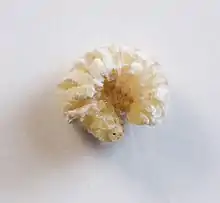Epipyrops exigua
Epipyrops exigua or Fulgoraecia exigua, the planthopper parasite moth, is a moth in the Epipyropidae family. It was described by Henry Edwards in 1882.[1] It is found in North America, where it has been recorded from New Jersey and Pennsylvania to central Florida, west to Missouri, Texas, New Mexico, Arizona and California.[2]
| Epipyrops exigua | |
|---|---|
.jpg.webp) | |
| Scientific classification | |
| Domain: | Eukaryota |
| Kingdom: | Animalia |
| Phylum: | Arthropoda |
| Class: | Insecta |
| Order: | Lepidoptera |
| Family: | Epipyropidae |
| Genus: | Epipyrops |
| Species: | E. exigua |
| Binomial name | |
| Epipyrops exigua (H. Edwards, 1882) | |
| Synonyms | |
| |
The wingspan is 8–13 mm. Adults are on wing from June to October.
The larvae feed on planthoppers of the superfamily Fulgoroidea. The first-instar larva is an ectoparasite of the planthopper, sucking body fluids from the abdomen beneath the wings.[3]

Larva
References
- "LepIndex - exigua Edwards 1882". The Global Lepidoptera Names Index. Natural History Museum, London.
- Moth Photographers Group. Mississippi State University.
- BugGuide
This article is issued from Wikipedia. The text is licensed under Creative Commons - Attribution - Sharealike. Additional terms may apply for the media files.